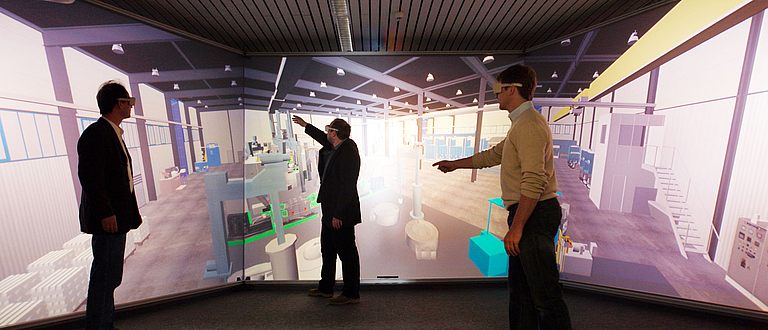Simulation Science
In nearly all areas of science and technology computer simulations play an increasing role for a priori and post calculations of processes, events and properties. Some research areas like long and short term weather and climate forecast completely depend on simulation technology. But also for example in automotive industry the end of classic prototyping and the beginning of completely simulation based product development has been announced. In material science new materials and compounds with desired characteristics are developed using computer science, which is named Computational Materials Design.
Regardless using which methods and having which objective targets when using simulation: By now Simulation science is an integral part in the principles of operations in many university and extramural research facilities, for industries and for authorities. The area of tasks ranges from the utilization of commercial simulation software to the development of new methods and efficient software for specific problems.
Simulation science depends very much on input from very different other disciplines. Ways of working from mathematics, computer sciences and also natural science and engineering are connected closely and are founding the interdisciplinary character of this area – commonly the area of simulation science is used as an example for transdisciplinary research. Simulation science covers both specific work for particular fields of application and also more methodic oriented cross-sectional and basic research.
Role and Mission
Simulation is a procedure primarily to analyze dynamic systems. In the simulation experiments are carried out on a model to gain insight into the real system. The simulation model is an abstraction of the real system, in which the properties (structure, function, performance) of the real system are reproduced. Simulations are used when testing the original is technically not possible or is prohibited by economic, ethical or safety considerations. Examples are crash simulations, wind tunnel simulations or business simulations.
The prediction of a technical or natural processes, in short computational simulation or computer simulation, has gained immense importance in many key sectors of the economy, industry and science. The advances in aerospace or the automotive industry may be mentioned as examples, which would not have been possible without the pre-calculation of complex processes. In the area of basic research, numerical simulations provide valuable information, for example, when experimental methods of investigation cannot be used. As priority areas the climate and earth system science, nanostructure physics, solid state physics, astrophysics, quantum chromodynamics, material science, theoretical chemistry, molecular dynamics, soft matter or biophysics can be mentioned.
While simulation in general can have quite an experimental approach to the subject, the focus of this research network is located primarily on the computer simulation, which represents an important area of simulation. Here, the dynamic systems are represented by appropriate mathematical models and solved symbolically or numerically by computers.
Disciplinarity, interdisciplinarity and transdisciplinarity
Simulation science unlike any other area of science relies on contributions from very different disciplines. These stem not only from the natural sciences and engineering but also from the life sciences, humanities, economics and social sciences.
An essential prerequisite for a successful and sustainable cooperation of scientists from these groups is that in terms of an inter- and transdisciplinary approach a common conceptual framework has to be established and that common strategies are developed. A pure multi-disciplinary "side by side plan - side by side act" cannot be in the interest of such a network. The latter would require that some aspects of the problems to be solved can be relatively clearly defined and assigned to the disciplines involved. This is in the region of simulation certainly not the case.
If we understand transdisciplinarity further more as a scientific approach that combines scientific knowledge and practice, this requires in this case the involvement of industrial partners and other institutions to have access to knowledge of institutions involved to practice.
Functions of the Centre
The specificity of the Simulation Science Center Clausthal - Göttingen lies in the complementary formation of the two universities, so that here the full range of simulation engineering applications in industry, technology, science and life science can be detected and operated. Because of this concentration, the center can not only act as a service provider for the industry but also as a nucleus for future excellence initiatives.
Joint research projects
In particular medium-sized and regional companies can afford very product- oriented research only. Also larger companies have limited their long-term research in the context of improving efficiency. On the other hand, however, no such resources were increased at the universities, which leads inevitably to a bottleneck in the innovation process.
The Simulation Science Center Clausthal -Göttingen wants to fill this gap partially. It sees itself in the role of a joint research department of German industry, thereby strengthening the economic power of the region. The SWZ acts as a central point of contact and hub to match suitable partners for joint research projects. Companies benefit from the skills developed at the universities and expand their knowledge base, especially in the prekompetitive area yet financially manageable. The universities benefit on the other side of new scientific questions from industry and the financial support of this research. In addition, young researchers are given an early insight into industrial processes and their challenges.
